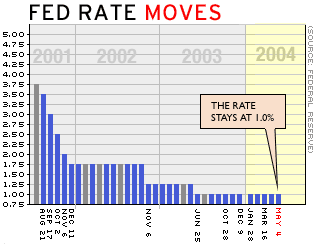NEW YORK (CNN/Money) -
For all the worry in U.S. markets about what the Fed will do and when the Fed will do it, it's possible that a good bit of the Fed's dirty work might already have been done for it -- by Wall Street itself.
Since the first of two blowout employment reports in March, amid signs of blossoming inflation, markets have been bracing themselves for a rate hike from the Federal Reserve.
For nearly a year, the Fed has kept its target for the fed funds rate, an overnight bank lending rate, at 1 percent, the lowest level since the Kennedy administration and the economic equivalent of rocket fuel.
Some economists believe the Fed has kept monetary conditions too loose for too long. Recent job gains could mean higher wages are on the way, and the recent acceleration in some closely watched consumer price measures, along with $40-per-barrel crude oil, could make for a nasty inflationary cocktail.
With that in mind, the implied yield on the fed funds futures contract -- a gauge of market expectations for Fed policy -- has risen to price in a quarter-percentage-point rate hike at the end of June and three more through December, leaving the fed funds rate one percentage point higher by the end of the year.

That would be a fairly gentle tightening path, all things considered, but other markets have reacted much more aggressively.
For example, since late March, the yield on the 10-year Treasury note -- a critical interest rate since it's the basis for mortgage rates -- has jumped a full percentage point.
Meanwhile, stock prices have been dead in the water, and the U.S. dollar has stabilized after a two-year nose-dive, as overseas investors entered U.S. markets, attracted by the prospect of higher interest rates.
None of this is good for the economy -- which is exactly the point.
| Related stories
|

|
|
|
|
"The markets are helping the Fed accomplish what it's seeking, to slow down the economy a bit, take some of the froth off," said former Fed Governor Lyle Gramley, now a senior economic adviser at Schwab Capital Markets.
The Fed is certainly aware of this, as evidenced by a speech last week by current Fed Governor Ben Bernanke, who said recent market activity "will reduce the financial impetus being provided to the economy and thus provide some check to nascent inflationary pressures."
This could mean the Fed will be more "measured," to borrow its term, when raising rates than some analysts fear. A slow, gentle tightening would be better for stock and bond prices than the kind of abrupt approach the Fed employed in 1994, when both stocks and bonds suffered.
In fact, recent signs of a less-robust economy have raised hopes of a kinder, gentler Fed and helped blue-chip stocks rally Thursday.
Fed can't sit tight
Other factors have pitched in to help the Fed. Oil prices, while not yet high enough to drown the economy, haven't helped much either, sapping consumers' discretionary income and making it costlier to do business. Income-tax refunds are lower than expected this year, and the effects of last year's tax cuts are fading.
And there are sporadic signs the economy is cooling. Retailers blamed Shrek 2 for lousy sales last week, but there are likely real-world reasons consumers, who fuel more than two-thirds of the total economy, are taking it easy, including record-high gasoline prices. Consumer sentiment has certainly stalled.
Wednesday brought news of dramatic plunges in new home sales and orders for durable goods made in U.S. factories in April. Thursday brought a report of higher-than expected unemployment claims and slightly disappointing gross domestic product growth in the first quarter.
Of course, this doesn't mean the Fed can just do nothing at all.
"Unfortunately, the Fed actually has to confirm the market's expectations," said Paul Kasriel, director of economic research at Northern Trust. "If the Fed doesn't move, then we'll reverse these trades. Yields will fall and the stock market will rise, and we'll kind of reset the shot clock."
What's more, the markets can't control everything in the economy. Some parts of the economy -- including home equity loans, adjustable-rate mortgages and credit card rates -- dance only to the music of the fed funds rate.
"The market has done part of the job, but this tightening is not yet substantial -- financial conditions are still near their loosest points in many, many years," said Anthony Crescenzi, bond market strategist at Miller Tabak & Co.
Some analysts worry that the Fed has been too lax, that inflation is inside the big, wooden horse they let through the gate and that the Fed will soon be forced to respond with a series of more aggressive rate hikes, a la 1994 -- bad news for stocks and the economy alike.
These Cassandras have some evidence on their side: inflation expectations are rising, and the consumer price index and the core CPI (which strips out food and energy costs) have risen at an annualized rate of 3.9 percent and 3.3 percent, respectively, in the past three months.
"I think the market is still not fully absorbing the risk that the current inflation cycle is already in an upswing that will last until the Fed stops it," said Russell Sheldon, senior economist at BMO Nesbitt Burns.
That means there's a "realistic chance," he said, "that the coming rate rise will be sharper or longer than in the early 1990s."

|